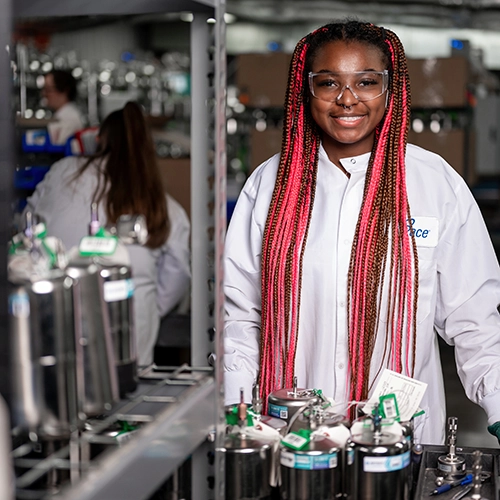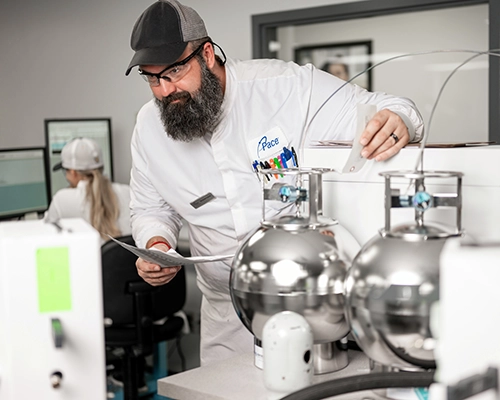Your Trusted Partner For Microbial Indoor Air Quality (IAQ) Testing
Indoor Air Quality (IAQ) Pace® provides comprehensive testing services to identify and measure biological contaminants, helping our customers ensure a safe and healthy indoor environment. With extensive experience in indoor air quality (IAQ) sampling techniques, fungal identification, and analytical interpretation, we offer expert guidance on all aspects of an IAQ investigation. Our personalized services, rapid turnaround times, and competitive pricing have made Pace® a leader in the industry.
Indoor Air Quality (IAQ) refers to the air quality within and around buildings and structures, especially as it relates to the health and comfort of building occupants. Indoor pollution sources that release gases or particles into the air are the primary cause of indoor air quality problems. Inadequate ventilation increases indoor pollutant levels by not bringing in enough outdoor air to dilute emissions from indoor sources and not carrying indoor air pollutants out of the area. Elevated temperature and humidity levels can also increase concentrations of some pollutants. Understanding and controlling common pollutants can help reduce your risk of indoor health concerns.
Microbial testing assesses the presence and concentration of airborne microorganisms such as fungi, bacteria, and viruses within enclosed environments. This testing is an important component of creating and maintaining healthy indoor spaces, as high concentrations of certain microbes can lead to adverse health effects, including respiratory problems, allergies, and other general health issues. This is commonly referred to as Sick Building Syndrome. Microbial testing helps identify the sources of pollutants and can guide effective remediation efforts, including cleaning, replacement of contaminated materials, and other changes to prevent future microbial growth.
Leadership in Energy and Environmental Design (LEED) rates a building’s environmental impact. A LEED-certified building uses fewer resources than average and promotes a healthy interior space. Among other strategies, a LEED-certified space ensures a healthy IAQ through adequate ventilation and by reducing pollutants and contaminants through filtration and cleaning.
Biological pollutants include mold, bacteria, viruses, pollen, dust mites, animal dander, and insect droppings. They can originate from various indoor sources such as pets, plants, building materials, humidifiers, and ventilation systems. When present in sufficient quantities, these biological contaminants can adversely impact the health of building occupants, leading to symptoms like allergies, asthma exacerbation, respiratory irritation, and infections.
Particulate matter (also referred to as PM or particle pollution) is a complex mixture of solid and/or liquid particles suspended in air. These particles can vary in size, shape, and composition. The Environmental Protection Agency (EPA) is especially concerned about inhalable particles 10 micrometers in diameter or smaller. Once inhaled, these particles can affect the heart and lungs, causing serious illness.

Sampling Techniques For Indoor Air Quality (IAQ) And Mold Detection

Non-culturable analyses involve the direct microscopic examination of air swabs, tapes, or bulk material. This allows for complete characterization of the fungal spores, fruiting structures, hyphal elements, and other fungal fragments in addition to pollen grains, elevated levels of bacteria, and identification of select non-biological materials. This total fungal characterization allows the identification of fungi that are either viable or non-viable upon culture. Direct reads can also be performed quickly, making them useful as a general screening tool and as an assessment tool for post-verification.
Culture-based sampling is useful for determining the presence of indoor fungal growth. It is the preferred approach when low-level fungal identification is required or when a high level of non-fungal background particulate could interfere with spore trap testing. Culture-based sampling can help detect indoor fungal contamination and identify recovered colonies to a low level, often to the species level. Airborne particles are collected using culture-based methods such as impaction or centrifugation. A growth medium is used to collect the particles, and after incubation, the colony counts are estimated to determine the airborne burden of culturable fungi.
However, there are some limitations to this method. Sampling intervals must be brief to avoid osmotic changes in the sampling media, which can increase the influence of transient airborne spore bursts on sample results. Standard growth media may not equally support the growth of all fungi present in the air, and some fungi may be entirely non-culturable. Furthermore, a significant proportion of the fungal content in the air is non-culturable and cannot be detected by this method. Long incubation times are often required for accurate identification, and attempts to expedite the process may bias the outcome.
Surface sampling is a process for collecting mold and bacteria samples from a surface. The process involves several techniques to ensure results are accurate and reliable. These techniques include:
- Swab samples: This technique involves the use of a cotton swab, which is rubbed against the surface to collect mold samples. The collected samples are then sent to a testing laboratory for further analysis. Alternatively, the swab may be rubbed against a petri dish, allowing a culture to grow for further analysis.
- Tape samples: This involves using clear tape to collect mold samples from the surface. The tape is pressed against the moldy surface and then removed to collect the samples.
- Bulk samples: This technique involves removing a piece of the potentially affected area, such as a piece of furniture or drywall, to be sent to a lab for testing. This method is useful for cases where the mold is difficult to access or when the surface area is too large for other sampling techniques.
It is important to note that each surface sampling techniques has advantages and disadvantages. Choosing the appropriate technique depends on the nature of the surface, the type of mold suspected, and the desired level of accuracy. Therefore, it is essential to consult with a professional to determine the best technique for your specific needs.
Who We Serve
Let us help you identify and address air quality issues within your facility to ensure a healthy and safe environment for occupants.
At Pace®, we understand how to support environmental consultants and engineers with indoor air quality testing. We can customize a LEED testing strategy to meet your client’s needs.
Home inspectors look for common signs of indoor air quality issues, like visible mold and/or water damage.
As an industrial hygienist and certified industrial hygienist, IAQ testing and exposure assessments may be part of your primary responsibilities.
Indoor air quality investigations typically examine ventilation efficacy, suspect indoor and outdoor contaminants, water and microbial contamination, and structural/material issues. Certified Safety Professionals often play a role in these assessments.
Additional Resources
Need to find a lab that can handle your unique requirements?
Contact us directly or download our list of environmental certifications across our network.